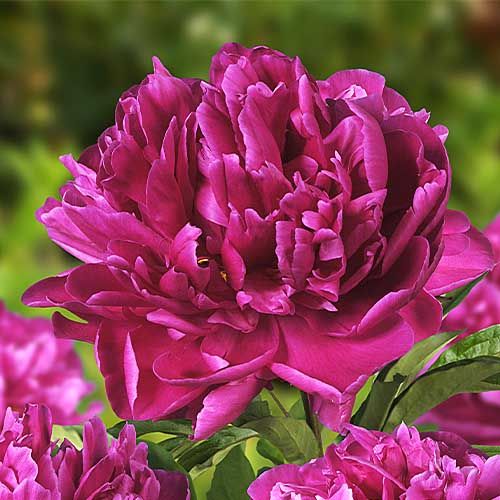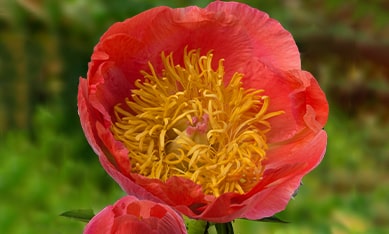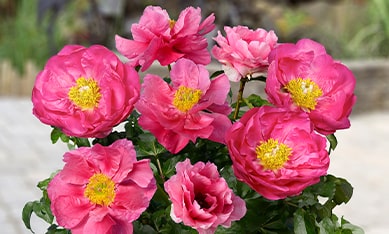Border Peonies
Border Peonies
Last Reviews
The Basics of Growing Peonies Border: Tips and Tricks for New Gardeners
Border Peonies are an attractive addition to any garden or home interior. They are easy to care for and provide stunning blooms in the late spring and early summer months. Here are some basic tips and tricks for growing Border Peonies:
Choose the Right Soil: The best soil for peonies is well-drained soil that is rich in nutrients. Ensure the soil has a pH level of 6.5 to 7.0, which is slightly acidic. Added organic matter, such as compost, will also help improve the soil;s structure and fertility.
Planting Depth: When laying Border Peonies, ensure they are placed at the right depth. The crown of the plant should be no deeper than two inches below the soil surface. Planting too deep can cause the plant to not flower, while putting it too shallow can expose the roots and cause the plant to dry out.
Watering: Border Peonies need consistent moisture, especially during the growing season. Ensure the soil is kept moist, but not waterlogged, by watering deeply once a week. During periods of drought, increase watering to twice a week.
Fertilization: Border Peonies benefit from a balanced fertilizer applied in the spring, just as new growth begins to appear. A 10-10-10 fertilizer is recommended, as it provides a balanced ratio of nitrogen, phosphorus, and potassium.
Pruning: Deadheading spent blooms will encourage the plant to produce more flowers. In the fall, cut the foliage down to ground level to prevent any disease or pest issues from overwintering.
Finding the Perfect Spot: Where to Plant Peonies Border for Optimal Growth
To thrive, Border Peonies requires at least six hours of sunlight each day. Make sure the location receives full sun when deciding where to plant your peony border. Avoid placing them in areas that are shaded as this may result in the plant growing longer and producing less flowers.
Moreover, the Border Peonies need sufficient airflow. Do not plant them in places that are prone to high humidity, such as near water. Having an adequate air circulation helps keep diseases and pest problems at bay.
Planting Peonies Border: Tips and Tricks for a Successful Garden
When purchasing Border Peonies, look for healthy plants with well-established roots. This will ensure successful transplantation and healthy growth. Here are some tips and tricks for planting peonies border:
Timing: Border Peonies are best planted in the fall, between September and October. This allows the plant to establish its roots before the cold winter months. However, they can also be planted in the spring as soon as the ground can be worked.
Spacing: Ensure there is adequate spacing between plants. Border Peonies require at least three feet of space between each plant to ensure effective air circulation and prevent overcrowding.
Mulching: By placing a layer of mulch around the plants base, you can help it retain moisture and stop weeds from growing. In the spring and fall, spread a two-inch layer of organic materials, such as wood chips or compost.
Caring for Peonies Border: A Comprehensive Guide to Maintaining Healthy Plants
Border Peonies are beautiful and elegant plants that can brighten up any garden or home interior. They require proper care to thrive and produce stunning blooms in the late spring and early summer months. Here is a comprehensive guide to maintaining a healthy Border Peonies:
Soil: Peonies thrive in well-draining soil that is rich in nutrients. Ensure the soil has a pH level of 6.5 to 7.0, which is slightly acidic. Added organic matter, such as compost, will also help improve the soils structure and fertility.
Sunlight: Border Peonies require at least six hours of sunlight per day to thrive. Ensure the area where you plant them receives full sun. Avoid planting them in shady areas, as this can cause the plant to become leggy and not flower as well.
Watering: Border Peonies require consistent moisture, especially during the growing season. Ensure the soil is kept moist, but not waterlogged, by watering deeply once a week. During periods of drought, increase watering to twice a week.
Fertilization: Border Peonies benefit from a balanced fertilizer applied in the spring, just as new growth begins to appear. A 10-10-10 fertilizer is recommended, as it provides a balanced ratio of nitrogen, phosphorus, and potassium.
Pruning: Deadheading spent blooms will encourage the plant to produce more flowers. In the fall, cut the foliage down to ground level to prevent any disease or pest issues from overwintering.
Propagating Peonies Border: How to Expand Your Collection of These Beautiful Blooms
Border Peonies are relatively easy to propagate, making them a great addition to any garden. Here are some tips on how to propagate your peony border:
Division: The most common way to propagate Border Peonies are through division. Wait until the fall, when the plant has gone dormant, to divide it. Carefully dig up the plant, being careful not to damage the roots. Divide the plant into sections, ensuring each section has at least three to five eyes. Replant the divisions in well-drained soil and water thoroughly.
Cuttings: Border Peonies can also be propagated through stem cuttings. Take a cutting in the late spring or early summer from the new growth on the plant. Remove the leaves from the bottom of the cutting and dip it in rooting hormone. Plant the cutting in well-draining soil and keep it moist until roots have formed.
Your Guide to Buying Peonies Border: Tips and Advice for Choosing the Perfect Plants
When buying Border Peonies, its wise to choose healthy plants with well-established roots. Here are some tips and advice for choosing the most suitable plants:
Quality: Look for plants with healthy, green foliage and no signs of wilting or yellowing leaves. Roots should be well-established and not bound.
Size: Choose plants that are the appropriate size for your garden or home interior. Border Peonies can grow up to three feet wide, so ensure you have enough space to accommodate the plant.
Timing: Border Peonies are best planted in the fall, between September and October. However, they can also be planted in the spring as soon as the ground can be worked.
Source: Consider buying Border Peonies for sale from a reputable nursery or online store. This ensures you receive quality plants that are healthy and well-cared for.
Frequently asked questions about Spring Flowering Border Peonies
When do Border peonies bloom?
Which varieties of Border peonies do you offer in your online shop?
How do I care for Dutch Border peonies?
Border peonies are generally easy to care for. Plant them in a sunny to semi-shady spot with well-drained soil. Regular watering and occasional fertilisation promote growth and flowering. After flowering, prune the plants back to promote healthy growth the following year.
Can I buy Dutch Border peonies in your shop?
Yes, you can buy Border peonies in our online flower and plant shop. We offer a selection of high quality plants and varieties at competitive prices. Visit our website to browse our current range and place your order.
Are there any tips for combining Border peonies with other plants in my garden?
Border peonies harmonise well with a variety of other garden plants. For example, you can combine them with perennials such as delphiniums, irises or daylilies to create colourful flower gardens. Make sure that the accompanying plants favour similar light and soil conditions.














